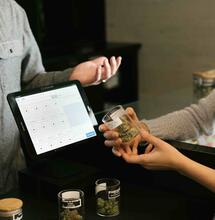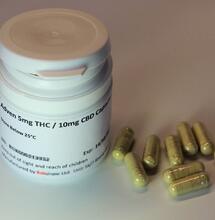Manipulating Bigger Buds

I was lucky enough to learn about plant manipulation from a friend long before I got my hands on any cannabis-related reading materials.
I was lucky enough to learn about plant manipulation from a friend long before I got my hands on any cannabis-related reading materials.
I was lucky enough to learn about plant manipulation from a friend long before I got my hands on any cannabis-related reading materials. After seeing the effects it had on my plants, I wanted to know why damaging branches and leaves increases the yield and what other techniques are there that I can use to manipulate even larger harvests. I’m often asked, “How many plants can I grow under this light?” My response is always to start with a different question: How can you fill the space? To answer that, you’ll need to first think about what techniques you’ll use to grow those plants.
At the heart of plant manipulation is the redirection of plant energy. Depending on the technique, this could mean a temporary redirection or a permanent redirection. In doing so, we’re asking the plant to concentrate on specific areas during its growth cycle to bring about certain consequences: stronger plant body, larger buds, etc. Similar to bonsai, we are changing the shape, size and energy flow within the plant to create these effects. We’re able to use these manipulation techniques to make any number of plants fill any size room, and all the while maximizing the harvest potential.
| FIM- Using fine tip scissors or a blade, remove just a bit of the center growth |
Foraging-
Something we all do as growers to care for our plants is to remove any foliage that looks unhealthy or that is damaged. Foraging, the most basic form of plant manipulation, refers to the removal of leaves that may appear discolored, damaged or necrotic. This allows the plant to displace the energy it would normally spend on those lower or damaged leaves and send it to the extremely efficient newer top growth. Our girls spend a lot of energy keeping any damaged or sick leaves going, so it’s always better to get rid of them at first notice and get the energy flowing to where we want it most. Lastly, foraging also involves the removal of larger fan leaves toward the top that heavily shade out the bottom of the plant, allowing light to penetrate further down.
Super cropping-
| TOPPING- The arrows point to the 2 nodes that will become apically dominant once the top is removed |
The first plant manipulation technique I learned was taught to me by a longtime friend whose garden was always producing enviable harvests. When I asked him for pointers so that my plants produced like his, he proceeded to kneel down over one of my plants and said, “Don’t freak out. I promise I won’t really hurt anything. The plant will be better than ever tomorrow.” I took a deep breath and gave him my utmost trust. I watched as he wrapped his thumb and a finger around the main stem (meristem) near the top of the plant, and then squeezed. He applied just enough pressure to damage it without breaking the stem completely. Then he gently folded over the stem at the point of the pinch, and stepped away. It was my turn to try. He pointed to another opportune spot on the plant, and told me to pinch just enough to feel a ‘pop’ between my fingers. This was my introduction to super cropping.
A major advantage to super cropping is that it strengthens the whole integrity of the plant, more specifically the stems, to support more vegetative growth and cola weight down the road. It can also be used to control the physical size and height of the plant without the need for chemicals that claim to have the same effect, such as bush load or phosphoload, which alter plant hormone regulation. Using this technique, we are intentionally damaging the inner vascular tubes to force the plant to heal itself, creating scar tissue and a ‘knuckle’ at the pinch point. It will eventually get the juices flowing again to the top growth but for the next 24-48 hours the plant will redirect the energy it would have expended on apex growth down to the foliage below the pinch point. It will ultimately result in a stem that is visibly thicker and stronger than one that was never super cropped.
To begin, select a plant that has a few sets of leaves and nodes at least 6-8” tall. The idea is to apply this technique at a location on the plant with the most active growth in order to redirect that energy to all areas below the point of pinching. Next, place your thumb and forefinger around the main stem in between the top two sets of nodes and squeeze. Apply only enough pressure to feel the xylem pop, much like relieving pressure on a blister. Don’t panic if you see some liquid ooze out of the pinched spot, it’s just water. The most important thing is to avoid severing the stem completely which would result in ‘topping’ the plant instead. The plant should fully recover within a few days, with the folded over stem once again reaching up toward the light and scar tissue forming the knuckle at the pinch point. You can repeat this technique as the plant grows vertically in between each ascending node; the scar tissue makes it too difficult to pinch the same spot twice and doing so may cause irreparable damage. But as for the rest of the plant, my personal super cropping motto is ‘If there is a spot to pinch, I’m pinching’.
GROWER TIP: running silicates as an additive also strengthens the cell walls of the plant, and when used together with cropping you will have an even strong plant.
Topping-
| LOLLIPOPPING- Follow the stem down sliding your pressed fingers to remove unwanted lower growth |
“Topping” is a term used by cannabis growers to refer to the cutting of the top main shoot. Some call it pinching because you can literally just pinch the top off with your fingers. I suggest always using scissors or a blade whenever you’re cutting anything off your plant. Otherwise it’s very easy to cause damage by trying to rip off leaves and branches; plus using tools ensures accuracy. As to not confuse this method with the pinching done for super cropping, we will call it topping. Removing the top transfers the apical dominance from the one terminal bud to the two nodes immediately below the point of cutting. Then, what was one apical dominant cola becomes two apical dominant colas. Admittedly, neither of these colas will ever be as strong as the main cola you just lopped off, but two is better than one in this case, or three or four! Topping could effectively double or triple your flowering potential. In addition, this process will also encourage rapid growth to all branches below the cut point, not just the two nodes directly beneath. Similar to super cropping, topping is another form of intentional damage to the plant for the purpose of redirecting energy, but with vastly different results in comparison. To apply the topping method to your plants, first select a space in between nodes near the top of the plant where you would like to cut, then simply cut and remove the top. Instead of just throwing these cuttings away, some growers will cut enough of the top off to be able to use them for clones and start a perpetual harvest cycle.
| SUPERCROPPING- Select a spot to pinch, fold over at the pinch point and allow 24-48 hours for the plants internal healing process |
Lollipopping-
This next method involves removing a significant amount of healthy growth from your plant, and for this reason it scares a lot of growers into not trying it. Always try techniques that are new to you on just one or two plants. That way your entire harvest won’t be ruined if executed incorrectly, and you’ll have a side-by-side comparison with the plants that didn’t get the new treatment. Lollipopping is on the opposite side of the spectrum from topping and yet can be used in conjunction with it. Here, instead of cutting or damaging new growth, you’ll concentrate on it by removing everything except the newest growth at the end of a branch. The term lollipopping comes from the way the branch looks after applying this manipulation. You’ll wind up with what looks like a lollipop stick with a delicious cola adorning the top (hence, a lollipop).
| LST/SCROG- Once you install your SCROG trellis you can then train the branches to grow horizontally using LST (Low Stress Training) |
Lollipopping isn’t ideal for every grower; some people don’t mind having the whispy buds grow toward the base of the plant, are happy with their cola size as is and choose not to apply this method. For those of us that want our plants to produce the biggest nuggets possible, this is the technique that will help provide those buds with enough energy to achieve their full potential mass. As we’ll discuss later on, this manipulation is used very heavily in the SCROG method.
FIM-
| SUPERCROPPING- Don’t get nervous if you see a bit of liquid ooze out at the pinch point, we damaged the xylem in this process so it’s just a little water |
Being fairly new, this technique has mixed reviews from growers and it’s probably because the results definitely vary from plant to plant even when performed exactly the same on each one. 100% accuracy when trying to cut just part of the node is almost impossible, but between trial and error and knowing your strain, you will find a happy medium for how much to cut. This technique is done by using fine tip scissors to cut a chunk out of the middle of the very top new growth, located on the main stem. It will look like a bunch of small leaves bunched up, but be careful to not cut it all off which would essentially be topping.
So far we’ve focused on plant manipulation to produce the biggest yield off of a plant. Now let’s talk about filling the space with plants. Because it’s not always more plants that gets you more yield, it’s also how you fill your space with the plants. With indoor grows the light source is typically coming from the same direction: overhead. Without a “sunrise” or “sunset” the triangular shape of most cannabis plants make it difficult for the stationary overhead light to penetrate down to the lower parts of the plant. This is where the importance of reflective material on the walls and even supplemental side lighting comes into play in your grow room, which is another option to contain and spread out the light you have. Height will also be an issue for the typical indoor grower, especially when growing sativa dominant strains that love to stretch. Growers have gotten creative of the years, coming up with a variety of ways for us to gain control over these issues.
| SUPERCROPPING- Apply enough pressure to feel a ‘pop’ between your fingers, but do not sever the stem completely. |
The Screen of Green (SCROG) method is one of the most popular grow room setups among indoor gardeners because you can grow full-size plants that produce heavily, in any size space. This technique combines lollipopping with topping, and introduces a trellis net or screen to act as a support system for the plant (and also to restrict its vertical growth). In doing so, it also creates a visible ‘sea of green’ with a stationary canopy of colas. A very beautiful sight I must add! This varies from the SOG method because you are not simply filling the space with as many plants as you can to get the sea of green look. Instead, you’re using a few plants and manipulating their size and shape to fill the space. This stationary canopy does create a down side however, allowing for almost no mobility, which in turn could make accessing the inner plants a task. Before you install the trellis netting, be sure to complete all your manipulations and verify that there are no pest issues that will require access to all the plants later on.
| FIM- Remember for FIM to leave a small percentage of the new growth in tact and remove the rest |
When it comes down to it, all of these manipulation techniques involve stressing out your plants – the key is understanding what constitutes a healthy amount of stress. Don’t forget that too much stress can cause your girls to hermaphrodite (among other things), possibly leading to an eventual loss that could set a grower back. So exercise caution and remember to test on a few plants before applying to the whole crop. As effective as these plant manipulations are they won’t get the job done on their own.
Your plants also need a full feeding schedule of light, water and nutrients to produce those picture-perfect buds. This is where physics, chemistry and biology all meet in the garden. Getting the balance just right requires some tinkering but the result is reaching your maximum potential.



